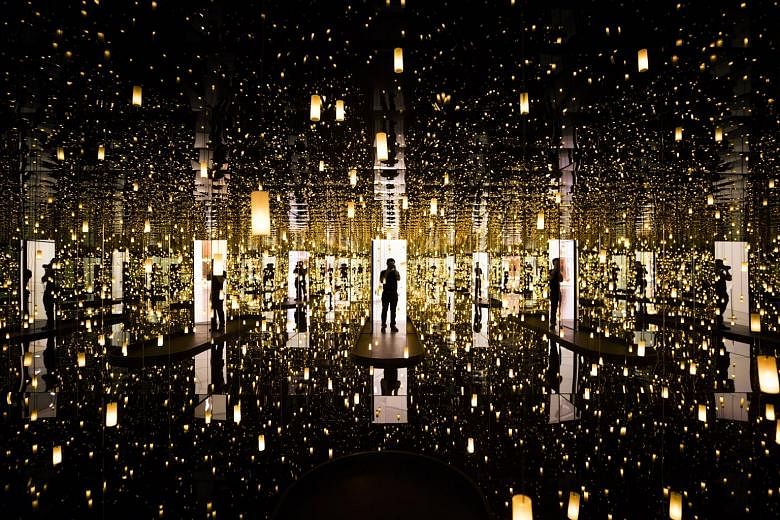WASHINGTON • The magic of the Infinity Mirrors exhibit begins as soon as the door is closed behind you. Surrounded by mirrors on all sides, visitors find themselves at the centre of a seemingly endless plain filled with brightly coloured lights and geometric sculptures.
But curators at the Smithsonian Institution's Hirshhorn Museum and Sculpture Garden, where the exhibit is on display until May 14, faced an early challenge - how to re-create that magic for visitors in wheelchairs.
"We had to work out how we could make this experience accessible for people with mobility disabilities," said Ms Beth Ziebarth, director of the Smithsonian's Accessibility Programme.
Mr Drew Doucette, who oversees multimedia and technology initiatives at the Hirshhorn, thought immediately of virtual reality: "It's really popular right now" among video gamers and tech geeks. "Rather than it being something that you play with, there's an actual use for it if it's around making things accessible to people as best as you can."
Virtual reality has found many uses beyond just entertainment. News outlets, non-governmental organisations and charities have turned to the technology to raise awareness for causes and tell stories in a more engaging way.
Applications have also been explored in the education, healthcare and defence industries, to name a few.
The Renwick Gallery, National Museum of Natural History and other Smithsonian sites have created virtual experiences in the past, often with the goal of extending the exhibit to students and others who might not be able to visit in person. The Infinity Mirrors exhibit marks the first time any have used virtual reality to make an exhibit accessible to those with disabilities, Ms Ziebarth said.
The wildly popular art exhibit is spread across six portable rooms, each filled with objects created by Japanese artist Yayoi Kusama. There is the room with canaryyellow pumpkins, the one with hot-pink spheres and the room with simple pendant lights. Mirrored walls replicate these items over and over again to create a sense of infinite space.
The installation is designed to be immersive and, as social media proves, makes for prime selfies.
But in three of the rooms, visitors must walk through 0.7m doorways and onto platforms less than 1.2m wide to achieve the full experience.
The Americans With Disabilities Act dictates that people who use wheelchairs be able to make a 180-degree turn inside the room, a requirement the Hirshhorn could not meet without altering each room and the artist's intention behind it.
It took roughly four months to plan and design the "Infinity Mirrors" virtual-reality experience on Unity, a program typically used to build video games, Mr Doucette said.
At first, an engineer tried to replicate each room literally. But designing a three-dimensional space covered in mirrors proved more difficult in the virtual world than the real one.
"We essentially had to take a step back from trying to re-create the rooms and get into the head of Kusama and say, 'What was she trying to do? How did she end up using mirrors?'" he said.
Without the limitations of a physical space, he added, mirrors were not necessary at all. Instead, the engineer merely created a digital copy of the room as it appears to the viewer, including black lines where the seams of the mirrors would appear. Early screen captures of the project earned Kusama's approval, and a representative from her studio signed off on the final version, Mr Doucette said.
The Hirshhorn offers six Samsung virtual-reality headsets that visitors with disabilities can request from volunteers on-site. They are available only to patrons who are not physically capable of entering the rooms, though, so do not look to VR to help you skip the exhibit's notoriously long lines.
Users wearing the goggles can pivot their head side to side or move forward as they would in the actual room.
It does not quite capture the immersive experience of standing in the actual mirrored rooms, but in a way, the view actually appears even more infinite than the original.
"I think that VR has a home in museums now, especially museums that are bringing in physical spaces and physical environments that you are supposed to walk into and experience, not just see something on the wall," Mr Doucette said.
"When you are told you have to go into the space to experience this, and you're not able to do that, this is the perfect solution for it."
WASHINGTON POST

